Recently updated on April 11th, 2025
Compliance training encompasses a wide range of topics, from data and privacy security to construction safety regulations.
To give you an overview of the most common types of compliance training—especially those that may directly impact your employees—we’ve curated a selection of examples for you.
We’ll also explore some quick and easy strategies to make your compliance training more engaging for learners.
Plus, we’ll show you how Arlo’s new elearning features can help you create compliance courses in just seconds!
1. Data Privacy and Security Training
Ensuring employees understand how to handle personal data, company data, and customer data is key no matter what position an individual holds. Training in this area goes beyond legal requirements, it should help build a culture of responsibility, trust and proactiveness around security.
Key areas that this training should cover include:
Understanding Data Types: Training should clearly define different categories of data, such as personal data (e.g., names, addresses, financial details), company confidential information (e.g., trade secrets, financial reports), and customer data (e.g., purchase history, contact information).
Explaining the sensitivity level of each type helps employees understand the potential impact of a data breach.
Understanding Data Types: Training should clearly define different categories of data, such as personal data (e.g., names, addresses, financial details), company confidential information (e.g., trade secrets, financial reports), and customer data (e.g., purchase history, contact information).
Data Handling Procedures: This section should detail the correct procedures for collecting, storing, using, and sharing data. This includes guidelines on password security, data encryption, secure file transfer protocols, and the appropriate use of company systems and devices.
Data Protection Regulations: Training must cover relevant data protection laws and regulations, such as GDPR, CCPA, or local privacy acts. Employees need to understand their obligations under these laws and the potential consequences of non-compliance, both for the organization (fines, legal action) and individuals (reputational damage).
Example of Data and Security Training
You can see below an example of data and security training offered by Arlo customer the Employer and Manufacturers Association (EMA). The training covers an introductory module on the NZ Privacy Act, and modules on Information Privacy Principles and Actions Businesses can take to ensure compliance with privacy acts.

2. Anti-Discrimination and Equal Employment Opportunity (EEO) Training
This training educates employees on relevant laws surrounding discrimination, harassment, and ensuring a respectful and inclusive workplace.
Key areas that this training should cover include:
Understanding Discrimination and Harassment: Training should clearly define different forms of discrimination (e.g., direct, indirect, systemic) based on protected characteristics such as race, ethnicity, gender, religion, disability, age, and sexual orientation.
It should also provide a comprehensive explanation of what constitutes harassment, including sexual harassment, and the different forms it can take (e.g., verbal, non-verbal, physical).
Relevant Legislation and Policies: Employees need to be educated on the specific anti-discrimination and EEO laws applicable in their location, as well as the organization’s own policies on these matters.
Promoting Inclusion and Respect: Training should emphasize the importance of creating an inclusive workplace culture where individual differences are respected and valued. This can involve exploring concepts like unconscious bias, cultural sensitivity, and the benefits of diversity.
Example of Anti-Discrimination and Equal Employment Opportunity (EEO) Training
The example below displays a program offered by Diversity Australia, titled “Equal Employment Opportunity (EEO) and Anti-Discrimination Program. Diversity Australia, as the name suggests, is an organization that provides diversity and inclusion professional services firm specializing in DE&I consulting and training.

3. Workplace Safety Training
Workplace safety, focusing on occupational safety regulations such as OSHA standards, fire drills, and safety protocols.
It aims to reduce workplace accidents and ensures employees understand their roles in maintaining a safe environment.
Key areas that this training should cover include:
Understanding Relevant Safety Regulations: Training must educate employees on the specific occupational safety regulations applicable to their industry and location (e.g., OSHA in the United States, or equivalent bodies in other regions like WorkSafe in New Zealand). This ensures legal compliance and provides a framework for safe work practices.
Hazard Identification and Control: Employees should be trained to identify potential hazards in their work areas and understand the methods used to control these risks, such as engineering controls, administrative controls, and personal protective equipment.
Emergency Preparedness and Response: Another important component is emergency preparedness. Employees need to learn about procedures for fire safety, including evacuation plans and the use of fire extinguishers. Training on first aid and responses to other workplace emergencies is also necessary.
Safe Operating Procedures (SOPs): Training on specific SOPs for equipment operation, handling materials, and performing tasks safely is essential. This ensures consistency in work practices and reduces the risk of errors that could lead to accidents or injuries.
Use and Maintenance of Personal Protective Equipment (PPE): When PPE is required, thorough training on its proper selection, use, maintenance, and storage is vital.
Example of Workplace Safety Training
The example below is some information offered by Arlo customer Hato Hone St John on the importance of First Aid compliance in the workplace. It also covers how an employer in New Zealand should go about designing a first aid training course for their workplace, and how they can assist.
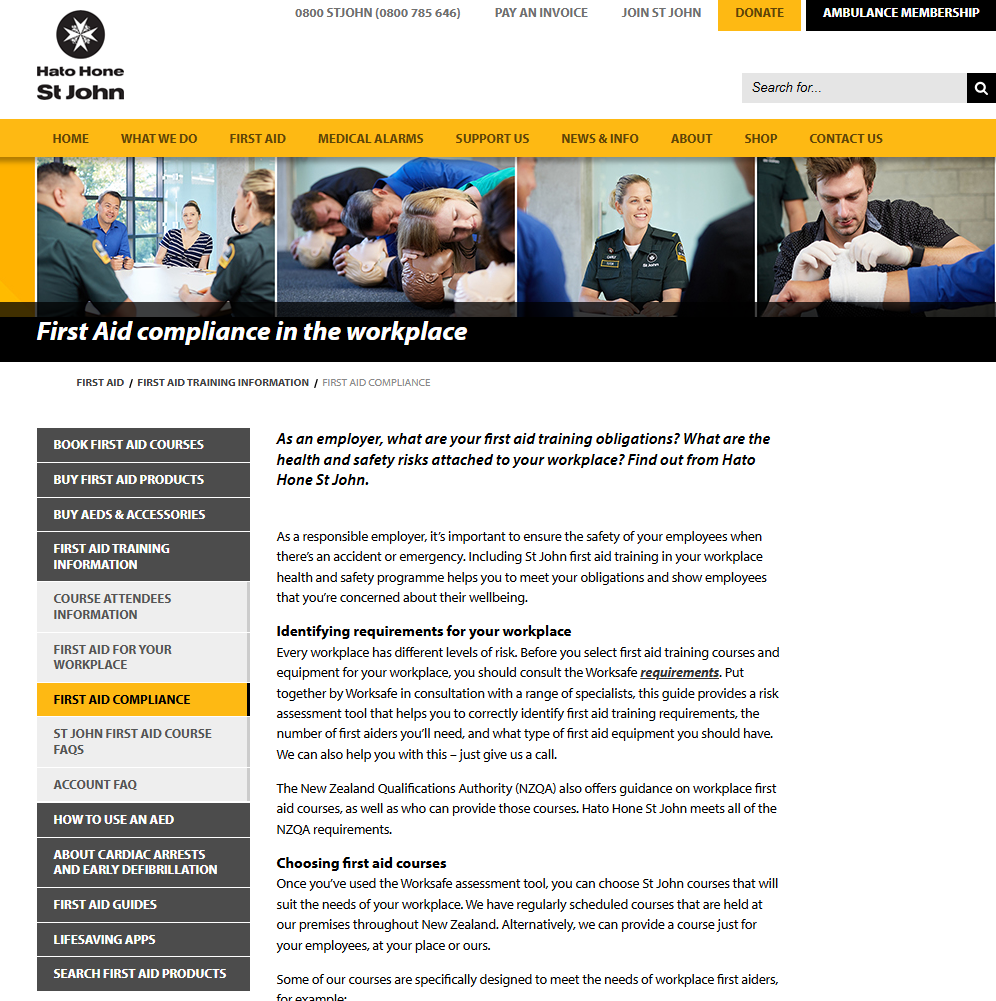
4. Anti-Bribery and Corruption Training
Anti-bribery and corruption training plays an integral role in safeguarding an organization’s integrity, reputation, and financial stability. It should equip employees with the knowledge and understanding necessary to navigate complex business situations ethically and legally.
Key areas that this training should cover include:
Defining Bribery and Corruption: Training should clearly define what constitutes bribery and corruption, including various forms such as offering, promising, giving, soliciting, or accepting anything of value to influence a decision or gain an unfair advantage. Employees need to understand these definitions so they can recognize and avoid such practices.
Relevant Laws and Regulations: Employees need to be educated on applicable anti-bribery and corruption laws and regulations, such as the Foreign Corrupt Practices Act (FCPA), the UK Bribery Act, local anti-corruption laws, and any specific laws that impact your specific industry.
Consequences of Non-Compliance: Training should clearly outline the potential consequences of engaging in bribery and corruption, both for the individual (e.g., fines, imprisonment, reputational damage) and the organization (e.g., legal penalties, financial losses, damage to reputation).
Example of Anti-Bribery and Corruption Training
The example below is a self-paced course offered by the Association of Certified Anti-Money Laundering Specialists (ACAMS), an organization that runs conferences and training on the detection and prevention of money laundering.
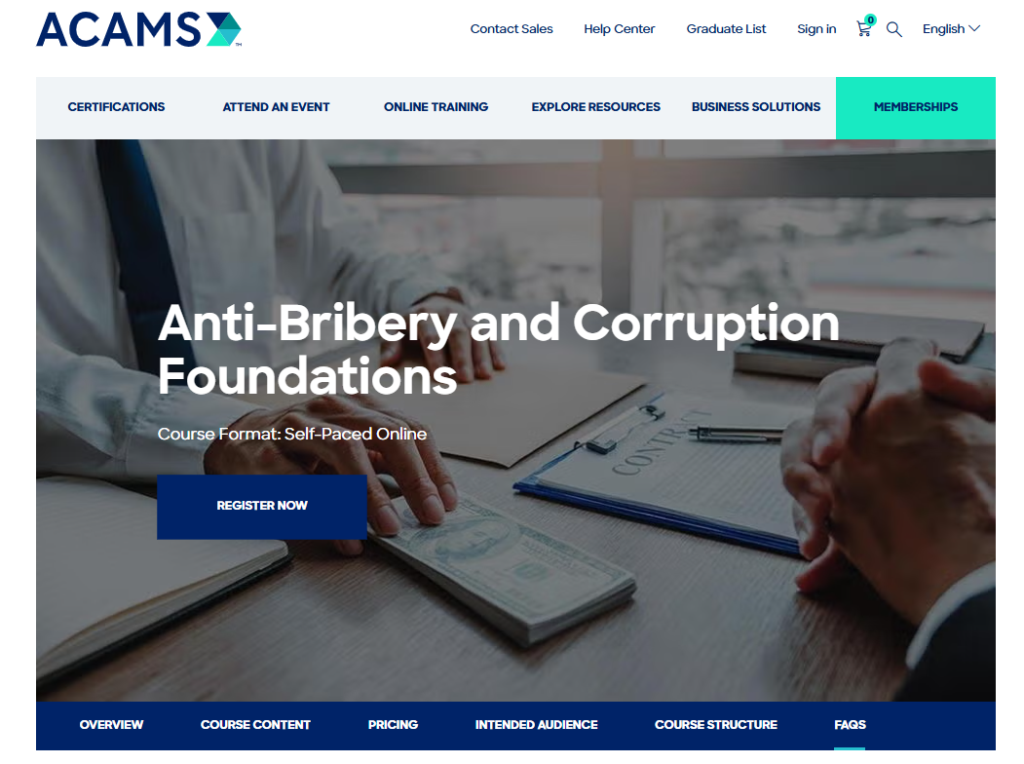
5. Code of Conduct and Ethics Training
Code of conduct and ethics training helps establish a strong ethical culture within an organization, and help ensure all employees understand and adhere to expected standards of behavior.
Key areas that this training should cover include:
Understanding the Company’s Core Values and Principles: Training should clearly articulate the organization’s core values and ethical principles, providing a framework for decision-making and behavior.
Overview of the Code of Conduct and Relevant Policies: Employees need a thorough understanding of the company’s code of conduct and related policies (e.g., conflict of interest, data privacy, anti-harassment).
Identifying and Managing Conflicts of Interest: Training should educate employees on how to recognize situations that may present a conflict of interest and the procedures for disclosing and managing them.
Example of Code of Conduct and Ethics Training
The example here is for a fictional company called Epic Training. This course has actually been created using Arlo’s very own elearning authoring tool. Its a feature that makes creating any form of workplace training effortless.
For example, if you wanted to create training for employees on your code of conduct, all you’d need to do is drop your code of conduct into the ‘Document to Course’ feature and watch your course come to life!
Check out the video below to see it in action 👇

6. Financial Compliance and Fraud Prevention
Financial compliance and fraud prevention training helps businesses maintain the integrity of their financial operations. It helps employees act ethically and legally with an organization’s financial resources, and teaches them how to identify and prevent fraudulent activities.
Key areas that this training should cover include:
Understanding Relevant Financial Regulations: Training should cover key financial laws and regulations applicable to the organization’s industry and location. This might include regulations related to financial reporting, anti-money laundering (AML), and data protection for financial information.
Internal Financial Controls: Employees need to understand the organization’s internal financial controls, such as segregation of duties, authorization limits, and reconciliation processes.
Identifying Different Types of Fraud: Training should educate employees on common types of fraud, including asset misappropriation, financial statement fraud, and corruption.
Example of Financial Compliance Training
Below is more of a general example of financial compliance training than a specific

7. Environmental Compliance Training
Environmental compliance training is vital for ensuring that an organization operates in an environmentally responsible manner, adheres to all relevant environmental laws and regulations, and minimizes its ecological footprint.
It equips employees with the knowledge and understanding necessary to support sustainable practices and avoid actions that could lead to environmental damage or legal repercussions.
Key areas that this training should cover include:
Understanding Environmental Laws and Regulations: Training should provide an overview of key environmental laws and regulations related to waste management, air and water quality, hazardous materials handling, and emissions control.
Company Environmental Policies and Procedures: Employees need to be familiar with the organization’s specific environmental policies, procedures, and best practices for sustainability.
Waste Management and Recycling: Training should cover proper procedures for waste segregation, handling, storage and disposal, as well as the importance of recycling and waste generation.
Example of Environmental Compliance Training
The example below is a, 8-Hour RCFA Refresher: California course offered by OSHA.com, to help environmental professionals in California maximize their compliance efforts for safety in the workplace.

8. Healthcare Compliance Training
Health compliance training is essential within the healthcare industry to make sure that organizations and their employees operate ethically, legally, and in accordance with relevant regulations.
This training is crucial for maintaining patient safety, data privacy, and the overall integrity of healthcare services.
Key areas that this training should cover include:
Understanding Healthcare Regulations: Training should provide a comprehensive overview of the key laws and regulations governing the healthcare industry in the region a business operates.
Patient Rights and Responsibilities: Employees of a healthcare business need to understand the rights and responsibilities of patients, ensuring that care is delivered ethically and respectfully.
Data Privacy and Security: Training must emphasize the importance of protecting patient data, covering topics such as data encryption, secure data handling practices, and protocols for preventing data breaches.
Example of Healthcare Compliance Training
The example below is the homepage of HIPAA Training a US based training company who are experts in HIPAA (Health Insurance Portability and Accountability Act). They offer HIPAA courses for individuals, and organizations.
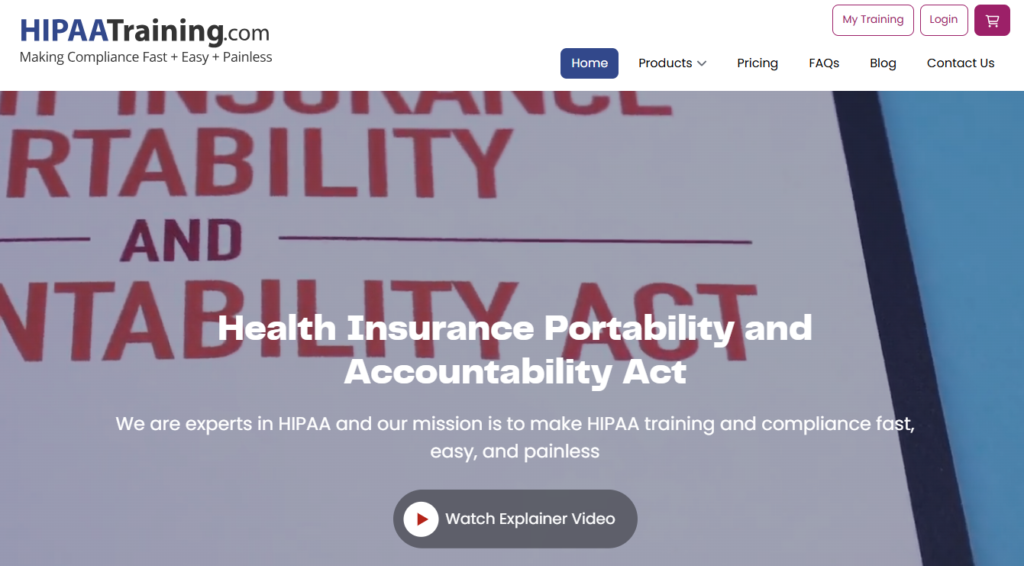
9. Cybersecurity Compliance Training
Cybersecurity compliance training is aimed at helping an organization protect their digital assets, data and reputation. It’s designed to help employees understand their role in maintaining a secure environment, while complying with laws and regulations.
Key areas that this training should cover include:
Understanding Cybersecurity Threats: Training should educate employees on cybersecurity threats such as phishing, malware, ransomware, social engineering and insider threats.
Data Protection and Privacy Regulations: Employees must understand the relevant data protection and privacy laws (e.g., GDPR, CCPA, and local regulations) and the organization’s policies for handling sensitive data.
Password Security and Best Practices: Training should emphasize the importance of strong, unique passwords, secure password storage, and MFA.
Example of Cybersecurity Compliance Training
The Cybersecurity example below is another one from Arlo customer the Employer and Manufacturers Association (EMA). The training covers strong passwords, how to keep devices secure, and how to spot phishing schemes.
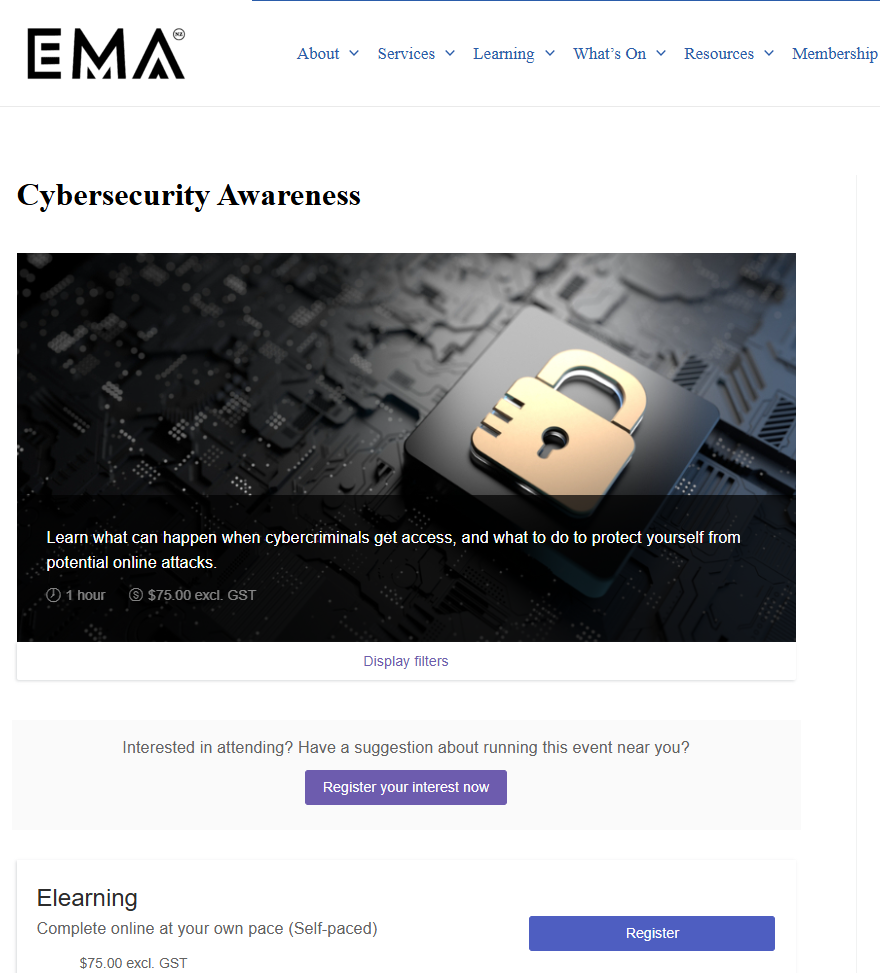
10. Export Control and Trade Compliance Training
Export control and trade compliance training is vital for businesses engaged in international trade so they ensure they can manage and comply with complex global regulations, avoid penalties and maintain their ability to operate in international markets.
Training programs in this area equip relevant employees with the necessary skills and knowledge to navigate the legal landscape of exporting goods, services and technology.
Key areas that this training should cover include:
Understanding Export Control Regulations: Training must cover the specific export control regulations relevant to the company’s industry and the countries it trades with.
International Sanctions and Embargoes: Employees need to be educated on international sanctions and embargoes imposed by various governments and international bodies.
Example of Cybersecurity Compliance Training
The example below is a course offered by The Knowledge Academy, an award winning provider of training courses.

11. Construction Safety Compliance Training
Construction safety compliance training should equip workers with the knowledge and skills to identify, avoid, and mitigate the numerous risks present on construction sites, which help prevent injuries, and ensure work can be carried out safely.
Key areas that this training should cover include:
Understanding OSHA Construction Standards (or Equivalent Local Regulations): Training must cover the specific safety standards and regulations set forth by OSHA in the United States, or the relevant occupational safety and health authorities in other locations (like WorkSafe in New Zealand).
Fall Protection: Given that falls are a leading cause of fatalities in construction, thorough training on fall hazards, fall prevention systems (e.g., guardrails, safety nets, personal fall arrest systems), and proper use of fall protection equipment is critical.
Safe Equipment and Tool Operation: Training must cover the safe operation of all types of construction equipment and tools, from hand tools to heavy machinery. This includes pre-use inspections, proper operating procedures, potential hazards, and maintenance requirements, reducing the risk of equipment-related accidents.
Hazard Communication: Workers need to understand the hazards associated with the materials they work with, including proper labeling, Safety Data Sheets (SDS), and safe handling and storage procedures for chemicals and other hazardous substances.
Example of Construction Safety Compliance Training
The example below is from Arlo customer All Borough Safety Council. The course covers basic safety and health information to entry-level workers in the construction industry, and forms part of the OSHA Outreach Training Program.
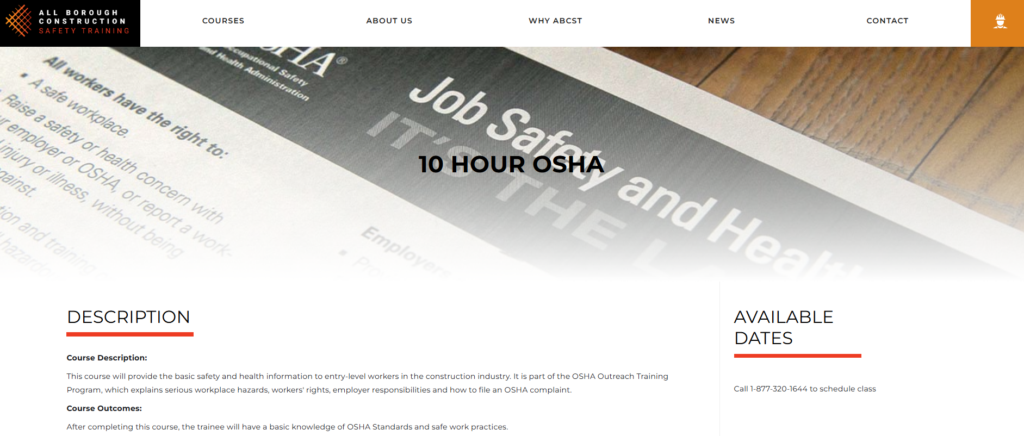
12. Electrical Code Compliance Training
Electrical work inherently involves significant safety risks, making thorough Electrical Code Compliance Training absolutely essential for electricians and anyone working with electrical installations. Adherence to the National Electrical Code (NEC) in the US, or equivalent local electrical codes in other regions.
It’s fundamental to staying compliant legally, preventing electrical hazards, and keeping workers and the public safe.
Key areas that this training should cover include:
Understanding the Relevant Electrical Code: Training must provide a comprehensive understanding of the specific electrical code applicable to the region. This includes its structure, key definitions, and how to navigate it effectively.
Example of Electrical Code Compliance Training
The example below is an Electricians Regulations Short Course offered by Arlo customer Wintec, a vocational training provider based in Hamilton, New Zealand, which includes electrical code compliance as part of its curriculum.

Tips for Creating Engaging Compliance Training
While the topics covered in compliance training are often complex or regulatory in nature, that doesn’t mean delivery has to be dry. There are plenty of ways to make your compliance training programs engaging and memorable.
Here are some tips:
1. Keep It Real
Use real-world examples that mirror the situations your team might encounter in the workplace. A relatable approach not only strengthens your overall compliance training strategy, but also encourages employees to see the training as essential to their roles.
2. Be Interactive
When delivering compliance training for employees, engagement is key. Use interactive elements like quizzes, real-time feedback, and scenario-based learning to encourage participation. These techniques are especially effective in online compliance training courses, where face-to-face interaction is limited.
3. Short and Focused
Busy professionals benefit from concise content. Use a modular approach when you create compliance training courses, so employees can learn in manageable, focused bursts. You can do this through creating microlearning modules through your training platform or learning management system (LMS).
4. Visuals Over Text
Turn dense regulatory information into digestible formats using visuals. Infographics and videos can boost engagement, especially in more technical areas like cybersecurity training. Visual aids can simplify complex policies and make them more accessible to all learning styles.
5. Make It Relevant
A generic approach rarely works. Tailor your compliance training to specific departments, roles, or risk areas to ensure it resonates with your audience. Relevance leads to better learning outcomes and higher retention.
6. Leverage Your Learning Management System
An LMS is a powerful tool for delivering and managing compliance training programs. It allows you to automate reminders, track completion rates, assess learner progress, and easily update course material.
7. Blend Online and In-Person Learning
To get the best results, consider a blended approach that combines in-person workshops with online compliance training courses.
Creating Compliance Training With Arlo
Creating engaging compliance training means having a platform in place that makes creating courses easy. Arlo contains all the elearning, and online training features you need to do this. Plus features for scheduling, and delivering in-person, virtual, blended and elearning training.
Creating a compliance course
There are three ways to create a compliance course within Arlo, check out the videos below to see each method in action 👇
Document to Course – Upload and convert existing documents into interactive eLearning content. Prepare your word doc, PowerPoint or PDF, upload it into the converter and watch your course come to life.
Generate a Course with AI – Enter a description of your course into Arlo’s AI assistant, select your tone, style, fonts, colors, and branding, and watch as your course is created before your eyes.
Build Your Course from Scratch – Use Arlo’s course and quiz templates to create your course from the ground up.
